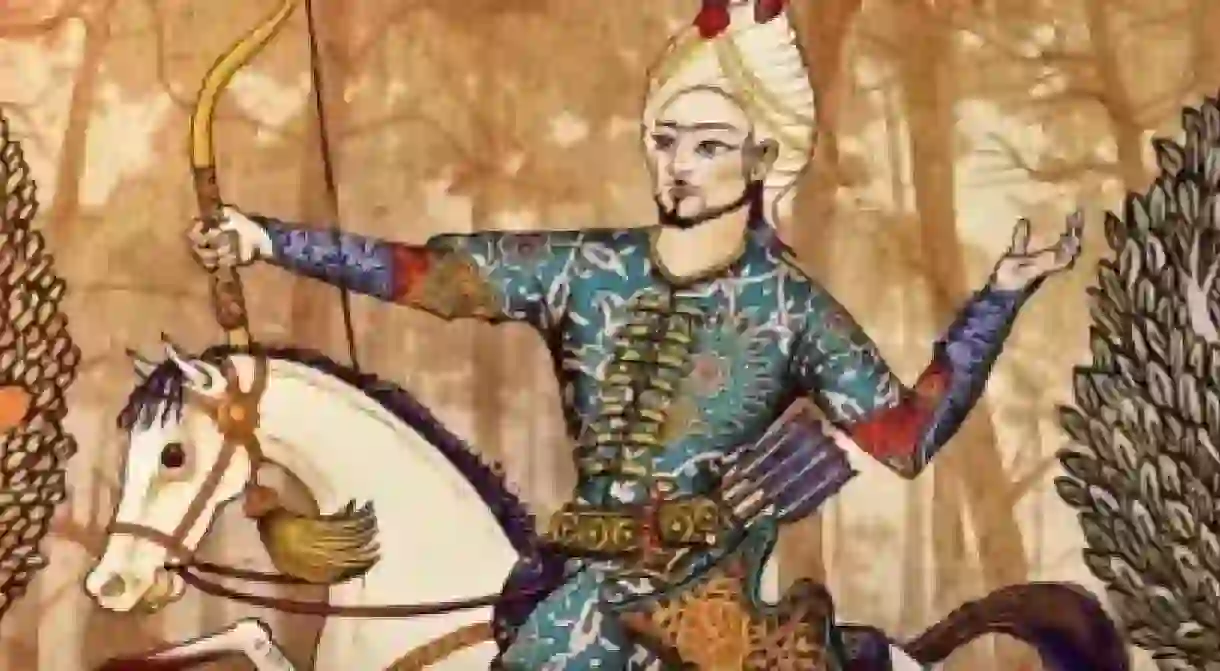The Seven Beauties Of Nizami Ganjavi

Written in 1197 by Azerbaijani poet and philosopher Nizami Ganjavi, the poem Haft-Paykar or Seven Beauties is one of the little-known gems of Oriental literature. Few, even in the most erudite circles, are aware that Giacomo Puccini‘s last opera Turandot is in fact a story of a Slavonic princess from Nizami’s poem. Traveling from East to West, Nizami’s story of Bahram’s wife Nasrin-Nush, narrated to him on Tuesday about the color red and a nameless Slavonic princess, has been introduced in the West as a story of Turandot, Princess of China. The tale has appeared in a number of literary pieces even before Giacomo Puccini spotted it for the plot of his last eponymous opera in 1926.
Haft-Paykar is a romanticized biography of King Bahram Gur, the Sassanian Emperor. The poem is distinguished by a number of non-linear plots, and is full of symbolism and hidden meaning. The focus is on a series of seven stories narrated to Bahram by seven Beauties, his wives and princesses from different corners of the earth, from Byzantium to India. In the tale, color is used to represent the seven stages of love of the Sufi tradition (similar to Attar’s Conference of the Birds), and the evolution from black (impurity) to white (purity).
A Brief Summary of the Seven Beauties Stories

Furak of India
On Saturday, the day of Saturn, King Bahram visits Furak, the daughter of the Rajah of India. Furak welcomes Bahram dressed in black in her Black Pavilion and seductively starts to narrate a story of black – ‘the most beautiful of all colors’, the color of dark night that lets the moon shine brighter, for only at night can one’s lustful dreams be fulfilled. Black is also the color of the youthful Indian Beauty’s eyes and hair.

Yaghma Naz of Turkestan
On Sunday when sunset bursts in gold colors, Bahram enters the castle of Turkestan Princess – Yaghma Naz. She tries to convince him that the color yellow is the best as it is the color of gold. Gold represents affluence and is associated with several positive qualities (‘his word is gold’). ‘Golden is the honey and all our sweets,’ the Beauty continues. Golden are the flames that warm you, that cook your meal, and that melt iron.

Naz Pari
Monday is the day of Jupiter and the day Bahram visits Naz Pari, the daughter of the king of Khwarazm. She tries to persuade Bahram that green is the best color to represent love, and narrates the story of a scholar longing to find a woman that he once saw in a park and could not forget for years.

Portrait of Nasrin-Nush
Nasrin-Nush
Since Bahram’s name also stands for the ancient Persian of ‘Red Planet’ Mars, scholars believe that the story narrated on Tuesday by Nasrin-Nush, the daughter of the King of the Slavs, is the heart of the poem. In her fable Nasrin-Nush talks about another Slavonic princess who sets strict conditions for her future husband, who will have to risk his life to answer her riddles. Like the stories, the Slavonic princess’ tale is educative, containing an important message for King Bahram: to rule his kingdom effectively, he will need to possess great wisdom. She, according to Dr. Christine van Ruymbeke, Nizami’s scholar from University of Cambridge, ‘will only belong to a ruler who shows qualities of courage, endurance, wisdom and honesty.’ She further explains that ‘the harshness of the treatment of those who fail the test is an allegory, translating exactly the fate of rulers who are unfit to keep their kingdom and are killed by contenders.’

Portrait of Azarbin
Azarbin of Morocco
On Wednesday, King Bahram visits Azarbin, the daughter of the king of Morocco, in her Turquoise Pavilion. She narrates a story of a man who started to wear exclusively blue clothing as a reminder of his salvation from the demons.

Portrait of Princess Humay
Princess Humay
Thursday is the day when Princess Humay welcomes Bahram into her Sandalwood Paivilion to narrate a story about the struggle between good and evil.

Diroste of Iran
Diroste (meaning ‘wholesome’) is a beautiful Iranian princess from the House of Kay Ka’us. Dressed in all white, Bahram steps into the white castle of the Iranian Beauty on Friday. She greets him and starts her story of innocent white. White is a color of purity and innocence. Only crystal clear water is tasty. White jasmine has a delicate fragrance. Day is clear as white, and while all the colors have some flaws, white remains untarnished. White is a color of marriage and in white we stand before the Creator.
The Seven Beauties poem by Nizami Genjevi contains examples of the symbols of Eastern wisdom and poetic eloquence. It is also one of the rare instances of early multiculturalism, whose timeless and geographical reach has influenced countless generations.
Nizami’s legacy in Western literature is briefly described in the YouTube video The Story of Continuity: from Nizami to Puccini – a pilot of curatorial initiative Milli Irsimiz – National Heritage of Azerbaijan.
The video and illustrations: (c) Asli Samadova (P) 2015 Asli Samadova and ASN (Azerbaijan Student Network) Illustrations by Creative 141 Worldwide













